
|
MUTANT BIG CATS - GOLDEN TIGERS |
Mutants are natural variations which occur due to spontaneous genetic changes or the expression of recessive (hidden) genes. Recessive (hidden) genes show up when there is too much inbreeding.
As well as anomalous colours, there are abnormally large or small individuals, longhaired individuals, short-tailed or even tail-less individuals. All of these occur in domestic cats so why are they less common in big cats? Wild cats displaying these traits may be less likely to survive to pass on the traits. In captivity, humans control which traits are bred, hence the multitude of domestic cat colours and types. In the wild, nature selects against any trait which does not enhance the animal's survival chances.
In the past, the obvious reaction to any unusual big cat was to shoot it for the trophy room. As a result, many interesting mutations may have been wiped out before the genes were passed on. Some colour mutations which would disadvantage a wild big cat are bred in captivity and are not viable in the wild. It is questionable whether these mutants should be perpetuated for the sake of curiosity or aesthetics alone.
Historical quotations are credited and are in the public domain. Original text is licensed under the GFDL. I am grateful to Paul McCarthy for researching and providing extensive material.
GOLDEN TIGERS
Different authors use different terms to describe colouration in tigers. The Van Ingens used “red tiger” in describing a possible golden tabby tiger, but the term “red” is used by earlier naturalists to mean “erythristic” (excessive red pigment) or for dark orange tigers. The golden tiger (golden tabby tiger, strawberry tiger) is even rarer than the white colour morph. There are records of golden Bengal tigers in India dating back to the early 1900s (as "stripeless" tigers). In 1929, Pocock described a brown tiger with stripes only a little darker than the coat's background colour and a similar tiger ("Jasmine") has been bred by Josip Marcan. Unlike current golden tabby tigers, the one described by Pocock was the Caspian subspecies and did not have the typical whte legs.
In “Natural History Of The Mammalia Of India And Ceylon” by Robert A. Sterndale, published in 1884, we find “Varieties of the Tiger.—It is universally acknowledged that there is but one species of tiger. There are, however, several marked varieties. [. . .] Shortly before leaving London, in 1878, Mr. Charles Reuss, furrier, in Bond Street, showed me a beautiful skin with deep soft hair, abundantly striped on a rich burnt sienna ground, admirably relieved by the pure white of the lower parts. That light-coloured specimens are found is true, but I doubt whether they are more common than the others. [. . .] Native shikaris, he says, recognise two kinds—the Lodhia Bagh and the Oontia Bagh (which last I may remind my readers is one of the names of the lion). [. . .] ‘The cattle-lifter again,’ says [Captain J] Forsyth, ‘is usually an older and heavier animal (called Oontia Bagh, from his faintly striped coat, resembling the colour of a camel), very fleshy and indisposed to severe exertion.’” It was thought that the animals became lighter in colour with age. The larger size of the Oontia Bagh might simply be age related, but it is a trait often seen in golden tigers in zoos.

“Tigers” by RI Pocock, in JBNHS v.33:pt.3-4 (1929): “the red tiger, illustrated in our coloured plate….is a unique type with all the black pigment abstracted from the stripes, leaving them reddish-brown and only a little darker than the ground colour…The dressed skin of a tigress ticketed ‘Northern slopes of Mount Elburz’ and presented by Col. R.L. Kennion who told me it was presented to him by a native chief. This tiger, represented in the coloured plate, is of extreme interest. The ground colour and the pattern are as in the Afghan specimen; but there is not a trace of black on the skin, all the stripes being brown and indistinctly defined owing to their approximation to the general hue of the coat.” While this might be a golden tabby tiger, Pocock suggested that it might represent one extreme end of the variation in stripe colour that occurred in the Caspian tiger; their stripes varied from black, through various shades of brown, to paler brown.
In Assam, in 1929, two light-coloured red tigers, which we might now call golden tabby tigers, were shot. According to the Van Ingen brothers who provided the photograph to the JBNHS: “The red tigress in the foreground was shot some years ago in Assam by the late Mr W G Forbes. The skin was white with the pale tan background and marked with fine stripes in a darker shade of tan. Curiously the three last stripes at the tip of the tail were black. The white tiger shown in comparison was pure white and marked with chocolate stripes. This tiger was shot by the Ruling Chief of Korea [i.e. Koriya princedom] also some years ago.” “Variation in Colour of Tigers and Panthers” by Van Ingen & Van Ingen, in JBNHS v.42:pt.3-4 (1942). J.C.Daniel provided further information on the skins in his 2001 book “The Tiger in India”: The two light-coloured tigers shot by W.G. Forbes of Hathikuli Tea estate in 1929 were described at the time of curing by Messrs. Van Ingen as ‘red tigers’.
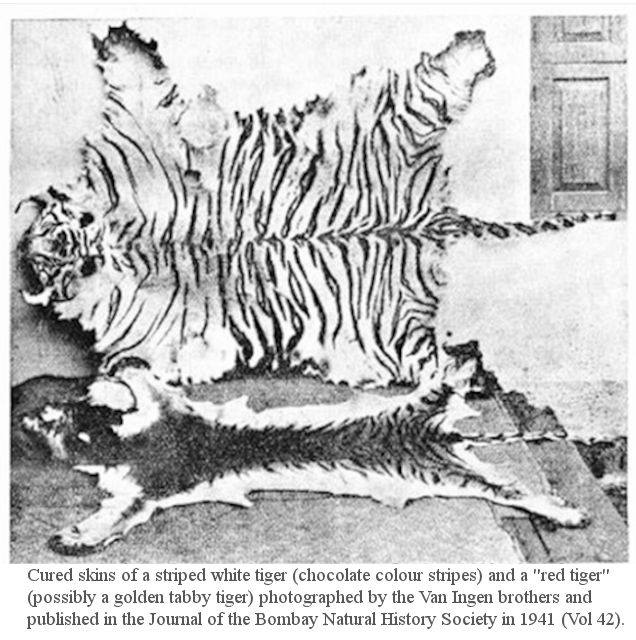
Many publications refer to the last recorded wild golden specimens being a pair shot in 1932 at Mysore Pradesh. This might be a mis-reading of an account of the two Assam tigers described by the Van Ingen brothers. In 2017, a possible golden tabby tiger was photographed in Kaziranga, Assam (NE India).
The first captive-born confirmed golden tigers occurred in 1987 (there is a report of a golden tabby born in 1983, but it can’t be verified). In 1987, Josip Marcan had two golden tabby tigers – a three month old male and a three week old female - valued at $600,000, which he said were the only two in the world (at that time). It apparently took him years of breeding to get the golden tabby colour. The male cub was on loan to Africa USA in San Francisco. The female (Barisal, born to orange female Abra) was with Marcan at the Clyde-Beatty Cole Circus at Fort Myers and was too young to be displayed to the public (News Press, 24th October, 1987, and News Press, 24th October, 1987).
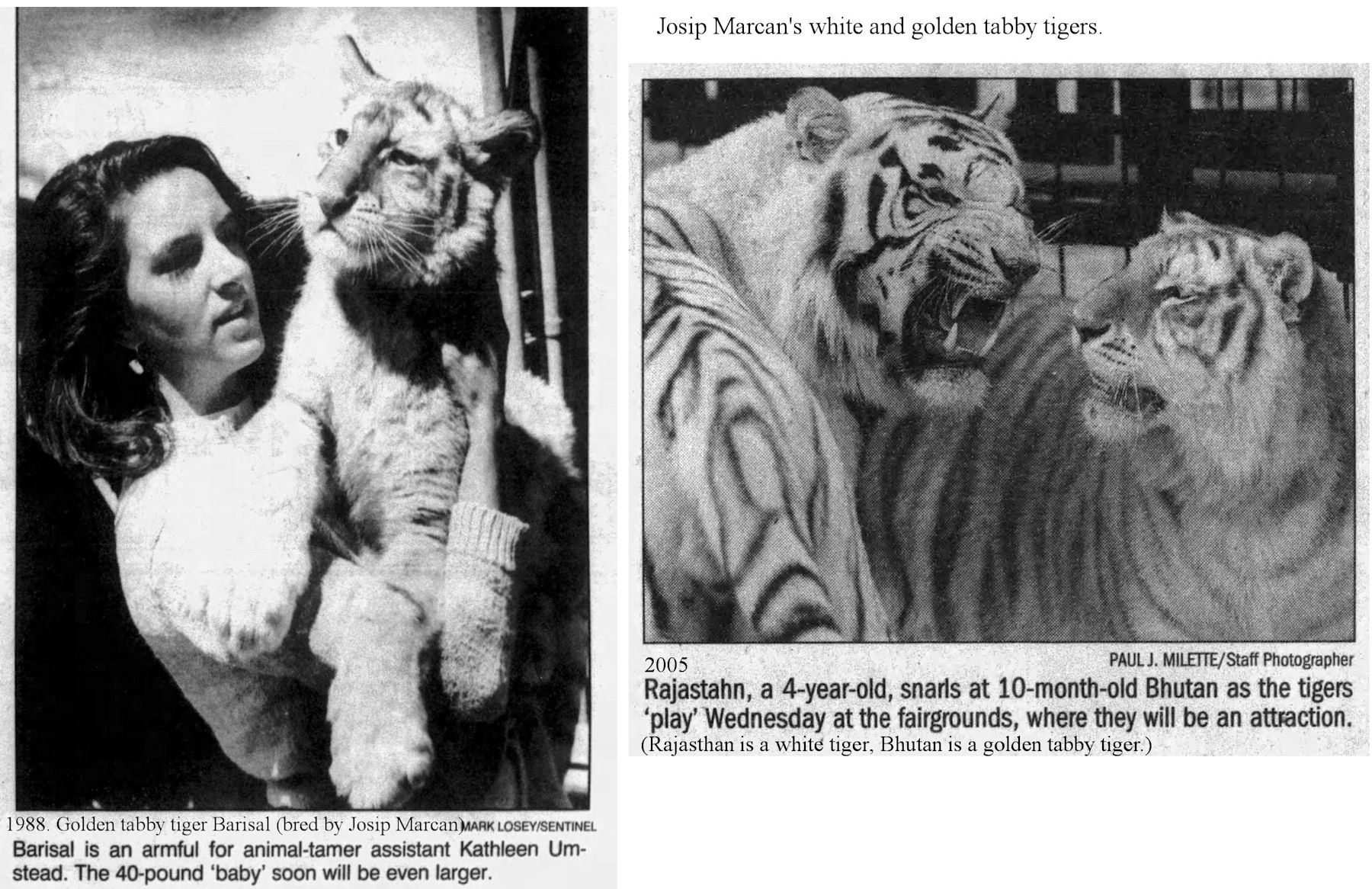
Although the first confirmed captive-born golden tigers was in 1987, a report in the Times of India (New Delhi) of October 10th 1979 stated that “brown” cubs were born to a white tigress, however "brown" is used by Indian zoos to mean the orange tiger. It has been stated that a carrier of the golden gene, that was not actually golden itself, was taken from Pakistan to an American east coast zoo by Josip Marcan after its parents and littermate had died and that this is the root of the colour in western zoos. However, modern golden tigers appear to occur alongside stripeless white tigers that trace back to white tigers Bhim and Sumita (a brother-sister mating). Continued inbreeding among close relatives causes recessive genes to emerge.
Chart 3p1a1a: Bhim and Sumita Pt 2 (large image, opens in new window)
Chart 3p1a1f: Bhim and Sumita Pt 3 (large image, opens in new window)
The gold colour is due to a recessive mutation, probably analogous to wide-band in domestic cats. This increases the width of the pale bands on each individual hair. The normal rich orange becomes pale gold forming a red saddle pattern, the stripes are red-brown to dark brown and normally pale areas become white, giving a striking contrast between coloured and white areas. The mutation causing the colour change seems also to affect the structure of the fur so that it is softer than that of a standard orange tiger. There is none of the black colouration of an orange tiger and this lack of black striping makes their white markings unusually prominent, especially on the face. Like white tigers, golden tigers are larger than standard orange Bengal tigers. They tend to have problems with their pelvic girdles and lumbar vertebrae.
As with the white tiger, the golden tiger is usually considered a form of Bengal tiger, although most have Amur (Siberian) blood as many breeders did not keep tiger bloodlines pure. Sherikon, a female at Tigerhomes (USA) is described as a golden Siberian tiger, though her colour would have come from a Bengal ancestor. Like white tigers, golden tigers must be inbred to preserve the colour. A golden tiger is mated to a standard orange tiger, resulting in standard orange offspring that are heterozygous for the golden colour. When one of the offspring is bred back to the golden parent, some of their offspring will be golden. The genealogies suggest that the gene came from a part-Amur-part-Bengal white tiger called Tony and may have originated in the Amur tiger. Inbreeding brother and sister Bhim and Sumita resulted in both golden tigers and in stripeless white tigers which are not seen in other bloodlines. Stripeless white tigers and golden tigers occur together as both types have the "wide band" gene, however the stripeless white tigers also have the chinchilla gene that produces the white background colour (not all golden tigers descend from Bhim and Sumita, but this seems to be the most prolific bloodline.).
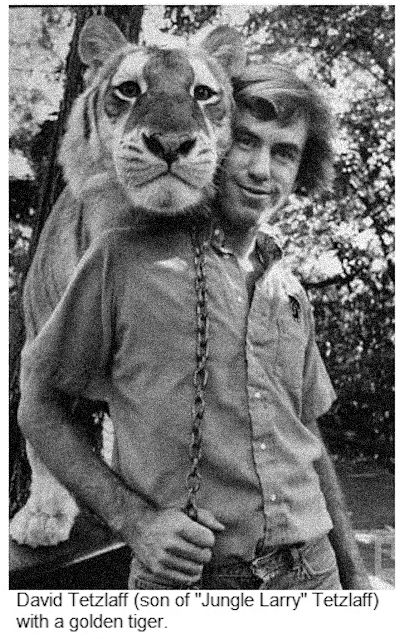
The Valley Of The Kings sanctuary in Wisconsin has a golden tiger named Jasmine. The Wild Animal Orphanage (WAO) in Texas has a rescued golden tiger called Bubba. He was one of 19 big cats rescued from a facility in Florida when the owner died. Aged 5, Bubba has severe hip problems (found in other golden tigers) and a degenerative bone disorder. WAO also have a golden tiger called Sahib.
|
|
|
There were no golden tabby tigers or stripeless white tigers reported at the Hawthorn Circus (which bred white tigers extensively) so the gene did not appear to be present in that breeding population. The first confirmed captive-bred golden tiger (outside of Asia) was probably born at the Cincinnati Zoo (where the first stripeless whites were born) and possibly to white tiger Bhim and his orange sister Kamala. Ed Maruska, the zoo director, was pictured holding a golden tiger cub. Andy Goldfarb referred to them as "strawberries." A golden tiger was acquired on loan by Glasgow zoo after someone there saw Columbus Zoo director Jack Hanna on TV with a golden tiger. Glasgow Zoo's golden tiger Butu (Bhutto) came from Longleat and was from the Columbus Zoo strain. Glasgow Zoo were of the impression that golden tigers necessarily carry white genes and are intermediate between white and orange. The colour coded chart of Bhim and Indira's descendents indicates that golden tabby tigers are orange/orange carrying white with an additional recessive gene - wide-band is the most likely candidate. Wide band would also cause ghost-striped white tigers. For a golden tabby mated to a white to have orange offspring means the golden tabby must be genetically orange. It seems that Chandi does not carry the golden gene, but Kaddu does.
Chart 3p1a3b: Bhim and Indira's Descendents, showing the genetics of golden tabby (large image, opens in new window)
While the first golden tiger cub born in captivity was in 1983 to normal orange Bengal tigers, one of the best documented births of a golden tabby occurred with a mixed colour litter of cubs on 23rd October 1998 at Dreamworld, Australia. The parents where a ghost-striped white called Mohan and a normal orange tigress called Samara. The cubs were normal orange male Sultan, white male Taj (the first white tiger born in Australia) and two were golden tabbies: male Rama and female Sita. The cubs were all hand-reared. This mixed litter strengthens the hypothesis that the same gene is involved in ghost-striped white tigers and in golden tabby tigers. Mohan would be homozygous for the recessive wide-band gene. Samara would have to be a carrier of that gene. Sultan only inherited one copy of the wide-band gene and is normal orange. The golden tabbies inherited a copy from both parents. Taj inherited white from both parents (Samara is a carrier) and wide-band from both parents.
Dreamworld White and Golden Tigers (large image, opens in new window)
Josip Marcan, the Croatian tiger trainer with the Clyde Beatty Cole Bros Circus, personally owns the performing tigers and was previously with the Hawthorn Circus. He had previously worked as a traioner for Cuneo. He has about 60 tigers, some leased to a safari park in Vienna, and appears to be the main source of golden tigers. Tigers bred by him have gone to MarineWorld/Africa USA in Vallejo, California, which in turn has provided tigers and trainers to Australia's DreamWorld, in the Gold Coast. Robert Baudy sent a golden tiger named Genesis, who had a white sibling, to the Out Of Africa park in Arizona. Genesis was born with deformed knee caps, which were surgically corrected with moderate success. "Sara the tiger whisperer", a trainer with the Ringling Bros, has several golden tigers in her troop. There are apparently golden tigers at the Valley Of The Kings park in Wisconsin and at Jungle Larry's Safari, in Naples Florida.
The Orlando Sentinel, 16th November 1996, carried a long article about Josip Marcan’s breeding programme. A litter of three gold tabby tigers had been born on October 26th, 1996 sired by a snow white tiger. A few days later, a litter of 4 cubs were born to golden tabby tiger Ravi. The 3 males and 1 female were sired by the same snow white tiger and the litter comprised a snow white cub, a grey-striped white cub, a black-striped white cub and a normal black-striped orange cub. According to Marcan, “When you breed them, you never know exactly what colors you’re going to get.” Marcan, who had been working with tigers for 35 years, said he was involved in genetic research that might make it a little easier to know what to expect from each mating.
In 1996, Josip Marcan exchanged one of his golden tabby tiger cubs for two normal orange tiger cubs owned by “Tiger Lady” Joan Byron-Marasek (Tigers Only Preservation Society, Route 537, Jackson, New Jersey). Byron-Marasek later lost her permit to keep tigers a tiger got loose on 27th January 1999 and subsequent investigations found conditions at her facility to be squalid and substandard. In 2003 the court ruled that her tigers be handed over to the Wild Animal orphanage in San Antonio, Texas, presumably including the golden tabby tiger. There is no report of Marcan retrieving his tiger, and no other information about it, but the last of the Byron-Marasek tigers died in 2019.
There are around 30 golden tigers in captivity including those at the Clyde Beatty-Cole Bros Circus (USA) and at Dreamworld (Australia) and - oddly considering their rarity - in big cat rescue centres (golden tiger Boris was previously the pet of boxer Mike Tyson). When Glasgow Zoo closed, their golden tiger went to a Spanish zoo where it produced several litters with a normal orange tiger. The Isle of Wight Zoo at Sandown has a white tigress (Zena) and a golden tiger male called Diamond. Diamond has been castrated to prevent him breeding with his normal orange sister (the pair are inseparable). The Isle of Wight zoo's big cats are rescued from closed zoos and private collections and are not required for breeding. Longleat Safari Park, England had a male golden tiger "Butu" (sometimes spelled "Bhutto") and then an elderly golden tiger called Sonar who died in 2006. Olmense zoo in Bukenberg, Belgium also has a golden tabby tiger along with white tigers, and a white lion.
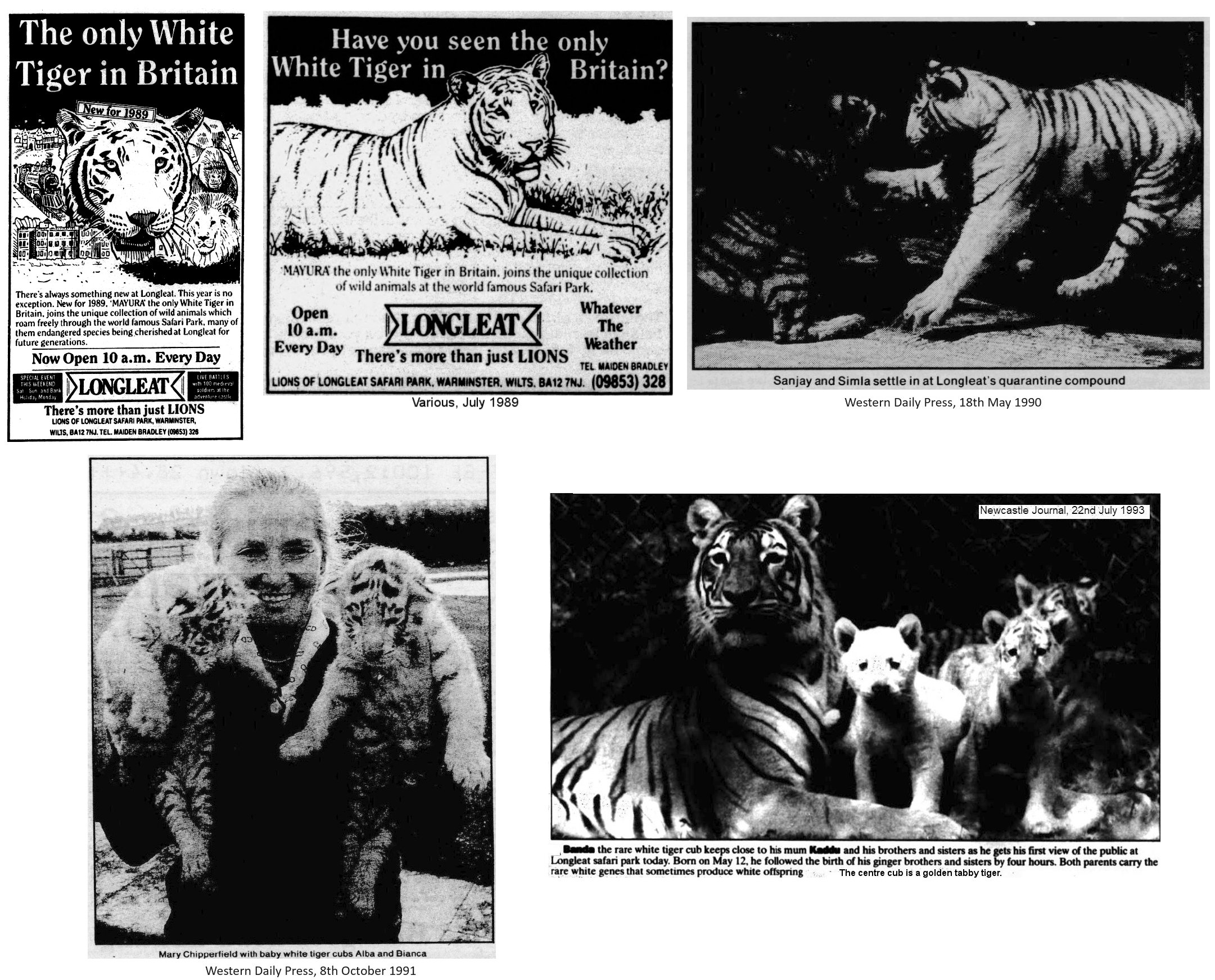
|
|
Butu, Longleat Safari Park's golden tiger that spent time at Glasgow Zoo is descended from a male white tiger imported in the late 1980s from Columbus Zoo, USA and containing Amur genes from Tony. This white male became resident male for the park's 6 to 9 females. Years later, in 1994, Longleat displayed a litter (presumed imported from Columbus Zoo, USA) obtained from an orange female heterozygous for white who had been mated to a golden tiger. This pairing produced golden tiger Butu, two orange tigers and a white tiger with no markings except for a few rings around the tail (exported to Japan). Butu was hand-reared and was one of 7 or 8 examples of the type bred by Longleat. While on loan to Glasgow Zoo, Butu was bred to homozygous orange tigress Ayesha, resulting in cubs that carry the golden gene. In 2000, Butu was to be sent to Spain to increase the gene pool. Instead, he went to Germany and was paired with a white female and with a golden female.
|
|
Although a few golden tigers have been recorded in the wild, they are a mutation, not a separate species. It is incorrect to say there are "only 30 golden tigers left in the world" - far from resurrecting an extinct animal, the mutation has been specially perpetuated as a zoo attraction. Just like white tigers or Persian cats, golden tigers are selectively bred by humans. Many conservationists believe that zoos should concentrate on pure bred tigers not on breeding aberrant colour forms, but it is important that such genetic variations remain in wild tigers. Their striking appearance puts them in demand for TV work and a Britney Spears pop video made them even more popular. Unless care is taken to outcross them to orange tigers, golden tigers risk following the same path as white tigers - descended from only a few individuals, highly inbred and mass-produced as attractions for zoos, circuses and private collections. The pelvic girdle and lumbar vertebrae problems appear to be a result of inbreeding and are not inextricably linked to the colour.
This photo on Twitter by Akashdeep Baruah of the Assam Forestry Dept, India, appears to show a golden tiger. It has the pale limbs and pale face indicative of that colour morph. This would mean that the recessive wide-band gene is still present in the tiger population in that region. This is the same region where stripeless white tigers were reported in the 1800s.
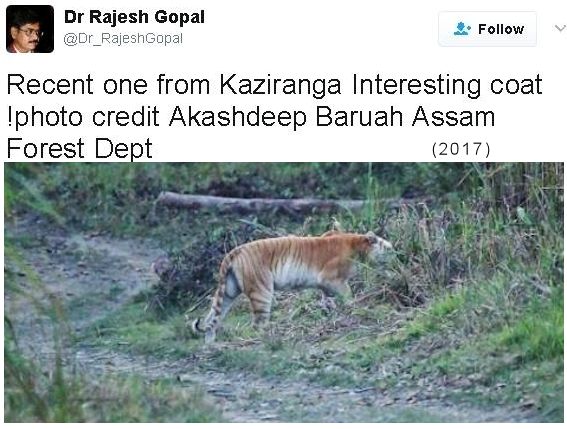
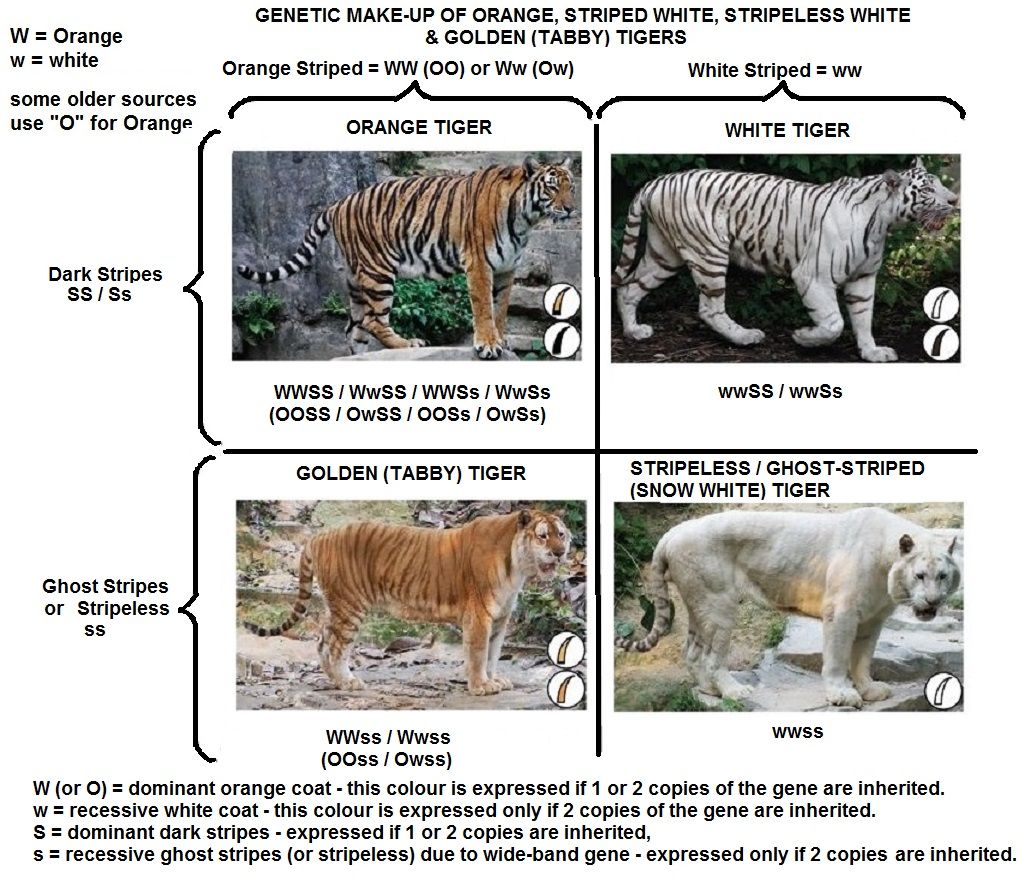
Textual content is licensed under the GFDL.
For more information on the genetics of colour and pattern:
Robinson's Genetics for Cat Breeders & Veterinarians 4th Ed (the current version)
Genetics for Cat Breeders, 3rd Ed by Roy Robinson (earlier version showing some of the historical misunderstandings)
Cat Genetics by A C Jude (1950s cat genetics text; demonstrates the early confusion that chinchilla was a form of albinism)
For more information on genetics, inheritance and gene pools see:
The Pros and Cons of Inbreeding
The Pros and Cons of Cloning
For more information on anomalous colour and pattern forms in big cats see
Karl Shuker's "Mystery Cats of the World" (Robert Hale: London, 1989 - some of the genetics content is outdated)
FOOTNOTE
Most white/golden tiger websites have a pro- or anti-agenda and variously claim to give “facts,” “truths” or debunk “myths.” There is too much misinformation too many hidden agendas. I stick to facts and deductions based on facts. Some information is documented, some is from personal correspondence with zoos, and some is from the recollections or personal notes of people involved with circus or zoo tigers. Sometimes personal recollection is the only information left to us because the organisations that bred or traded the tigers have closed and their records were destroyed. Even the different editions of tiger studbooks are inconsistent.
Information originating from my pages, which are frequently updated, has been widely copied on those other sites. Some users of my information have later tried to claim I copied their work.
|
BACK TO HYBRID & MUTANT BIG CATS INDEX |